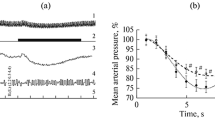Summary
The study was devoted to changes in the neurons of certain parts of the brain in rats and cats under the influence of nivaline. Nivaline was injected subcutaneously and intramuscularly in 1, 6, and 12 mg/kg doses. It was found that nivaline injections in small doses were followed by an increase in the number of hypo- and hyperchromatic cells in the brain cortex and the reticular formation of the brain stem, these cells being represented in various correlations in different parts of the brain cortex.
In the subcortical formations, the central gray matter of the midbrain, and the corpora quadrigemina the changes were mainly manifested by swelling, chromatolysis and vacuolization of the neuron cytoplasm. The changes in the hypothalamus neurons resembled those in the reticular formation of the brain stem.
With an increase in nivaline dosage, changes in the neurons and particularly their dendrite systems increased too. Upon injection of large doses of the preparation the structural changes of neurons in different analyzer systems showed similar features.
Similar content being viewed by others
Literature Cited
G. P. Zhukova and T. A. Leontovich, In book: Material of the 1st Scientific Conference Devoted to Problems of the Physiology, Morphology, and Pharmacology of the Reticular Formation of the Brain [in Russian], Moscow (1960), p. 48.
R. Yu. Il'yuchenok and R. U. Ostrovskaya, Farmakol. i toksikol., 4 (1962), p. 401.
G. N. Kassil', L. A. Latash, and E. M. Rutman, et al., Dokl. AN SSSR, 149, 2 (1963), p. 464.
S. Kirchev et al., Vopr. kurortol, 4 (1962), p. 299.
M. D. Mashkovskii and R. P. Kurglikova-L'vova, Farmakol. i toksikol., 6 (1951), p. 27.
M. D. Mashkovskii and R. Yu. Il'yuchenok, Zh. nevropatol. i psikhiatr., No. 2 (1961), p. 166.
M. D. Mashkovskii and R. A. Al'tshulei, Farmakol. i toksikol., 2 (1962), p. 168.
D. S. Paskov, Pharmacological Characteristic of the Alkaloid Nivaline as an Anticholinesterase Substance [in Russian], Doctoral Dissertation, Leningrad (1958).
É. N. Popova, Byull. éksper. biol., 2 (1961), p. 72; 1 (1962), p. 107.
S. A. Sarkisov and T. M. Mokhova, Zh. nevropatol. i psikhiatr., No. 8 (1958), p. 907.
G. D. Smirnov and R. Yu. Il'yuchenok, Fiziol. zh. SSSR, 10 (1962), p. 1141.
M. B. Éidinova and E. N. Pravdina-Vinarskaya, Infantile Cerebral Paralyses and Means of Overcoming Them [in Russian], Moscow (1959).
J. Altman and M. Carpenter, J. comp. Neurol., 116 (1961), p. 157.
N. Boshev, D. Paskov, and N. Nikolova, Folia med. (Plovdiv),3, (1961), p. 213.
W. Nauta and J. Kuyper, In book: Reticular Formation of the Brain [Russian translation], Moscow (1962), p. 13.
K. Pernov, Psychiat. Neurol. med. Psychol. (Lpz.)
A. Rasmussen, J. comp. Neurol., 63 (1936), p. 501.
F. Rinaldi and H. Hirnwich, Arch. Neurol. Psychiat, 73 (1955), p. 387; 396.
J. Szentagothai et al., Hypothalamic Control of the Anterior Pituitary. Budapest (1962).
Th. Taschev and N. Kilimov, Folia med. (Plovdiv), 3 (1961), p. 65.
Author information
Authors and Affiliations
Rights and permissions
About this article
Cite this article
Popova, E.N., Bogolepov, N.N. Changes in neurons of certain regions of the brain under the influence of nivaline. Bull Exp Biol Med 59, 572–577 (1965). https://doi.org/10.1007/BF00783088
Received:
Issue Date:
DOI: https://doi.org/10.1007/BF00783088



